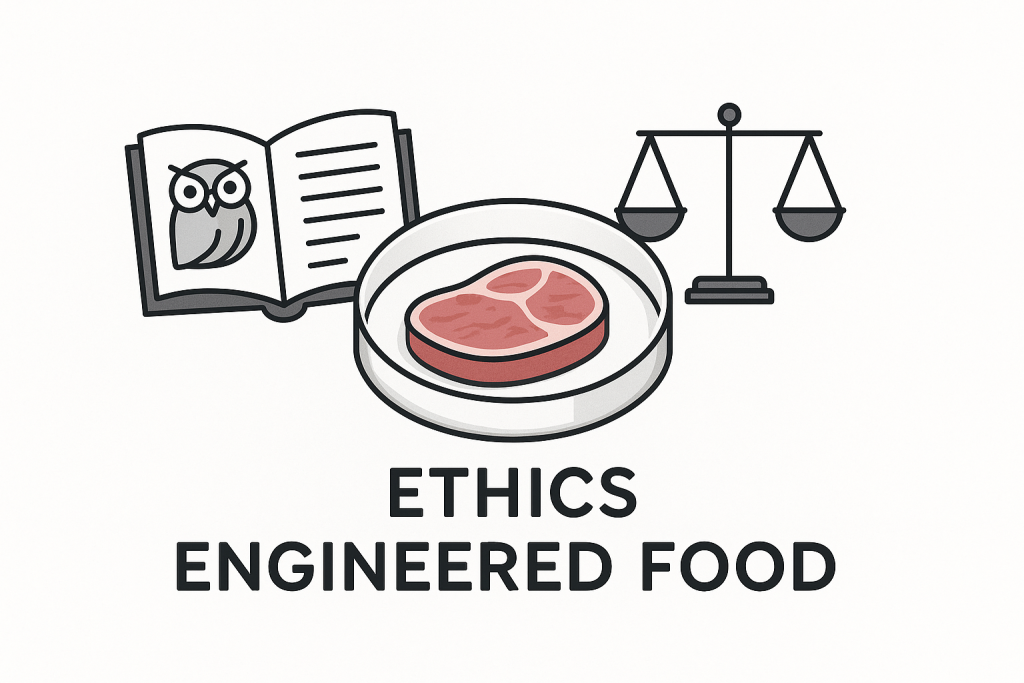When food becomes technology, ethics becomes part of the curriculum.
Why Ethics Belongs in Food Science
Food innovation is no longer confined to farms and factories—it’s happening in labs. From cell-based meat to CRISPR-edited crops, biotechnology is rewriting the foundations of agriculture.
For educators, this presents both a challenge and an opportunity. How do we help students think critically about the moral dimensions of food systems that no longer depend on soil, sunlight, or livestock?
Teaching the ethics of engineered food isn’t about taking sides. It’s about building the capacity to ask informed, value-based questions in a rapidly changing world.
Framing the Conversation
When discussing food biotechnology, the goal is to integrate three overlapping lenses:
- Scientific: What do we know about how it works?
- Cultural: How does it affect communities, traditions, and identity?
- Ethical: What values guide our choices in innovation?
These lenses help students move beyond simple binaries—“natural vs. artificial” or “good vs. bad”—and instead explore complex trade-offs like sustainability, safety, and social justice.
Teaching Cell-Based Agriculture
Cell-based agriculture—the process of growing meat, dairy, or other proteins from cultured cells—raises immediate ethical questions:
- Is it ethical to produce meat without animals?
- How do we define “natural” when food is grown in a bioreactor?
- Who gets access to these new food sources?
Educators can use case studies to ground abstract debates in real-world examples. For instance, examining the first FDA-approved cultivated chicken in the U.S. helps students explore regulatory ethics, food labeling, and public trust.
Genetic Editing and Responsibility
CRISPR and other gene-editing tools allow scientists to alter the DNA of plants and animals with unprecedented precision. But precision doesn’t eliminate ethical complexity.
Encourage students to consider:
- Should we edit crops to resist drought if it risks biodiversity?
- Who decides what counts as an acceptable modification?
- How do we balance innovation with precaution?
These questions help shift the focus from the technology itself to the decision-making frameworks that shape how it’s used.
Food Systems and Cultural Context
Food is never just biology—it’s identity, heritage, and meaning. Engineered food technologies challenge long-held assumptions about what counts as “real.”
Educators can connect this to global and cultural studies by examining how different societies respond to food innovation. For example:
- In Japan, lab-grown seafood is framed as preservation of tradition.
- In Europe, skepticism around GMOs ties to cultural notions of purity and naturalness.
- In the U.S., debates often center on corporate influence and consumer rights.
Understanding these perspectives teaches empathy across cultures and highlights the importance of inclusive dialogue in science communication.
Methods for Classroom Integration
Ethical literacy can be woven into science, social studies, and even art curricula. Here are some approaches:
- Debate Modules: Assign teams to represent different stakeholders—scientists, farmers, consumers, policymakers—and explore competing values.
- Scenario Design: Have students imagine ethical guidelines for a new synthetic food company.
- Case Comparison: Analyze historical examples like pasteurization or synthetic fertilizers alongside modern biotech to reveal continuity in ethical questions.
The goal isn’t to produce consensus—it’s to strengthen reasoning.
Linking Ethics to the Future of Work
Teaching the ethics of engineered food also prepares students for the future of employment in biotechnology, data science, and sustainability. Employers increasingly seek people who can combine technical literacy with ethical judgment.
This emerging field of food ethics education isn’t about limiting innovation; it’s about ensuring innovation remains accountable.
Why Parents Should Care
For parents, these conversations help frame how children understand what they eat and why it matters. As food becomes more synthetic and software-driven, family discussions about nutrition, environment, and equity take on new relevance.
Raising ethically aware consumers means raising future decision-makers who can question—not just consume—technology.
Closing Thought
The question isn’t whether engineered food is right or wrong—it’s whether we’re preparing the next generation to navigate its complexity responsibly.
Ethics, when taught early, doesn’t just shape opinion. It shapes judgment—and that may be the most vital ingredient in our collective food future.


